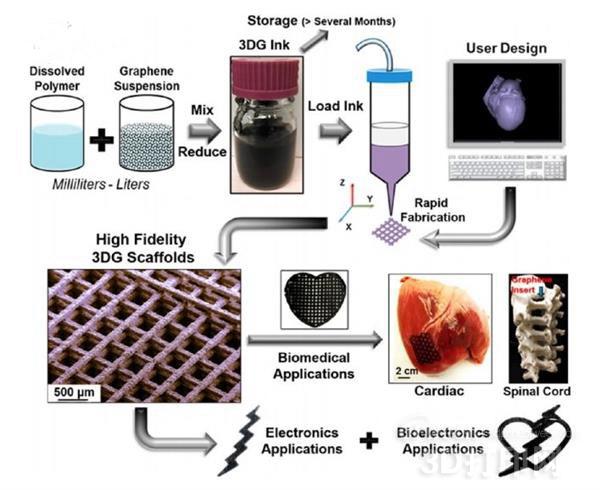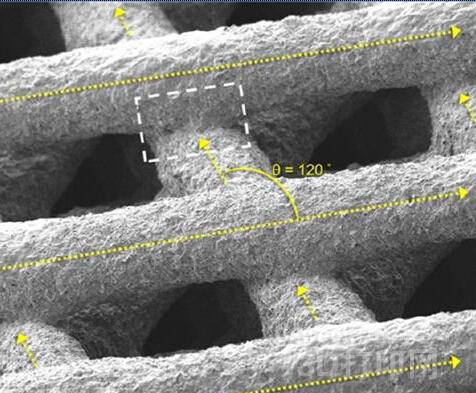A few months ago reported from Northwestern University in the United States, a team of scientists developed a high content of graphene can be 3D printing ink (graphene content as high as 60%), so as to bring breakthrough results for
3D printing graphene structure. You know the 3D print graphene structure, called the current global 3D printing research field of the Holy grail. Look now, scientists are closer to this holy grail. Recently, this same team, in the Ramille Shah under the leadership of the further improvement of the graphene 3D printing ink, so that the content of graphene (by volume) from 60% to 75% increased significantly.
Graphene is a two-dimensional material composed of carbon atoms in single sheet structure: it is the most thin material, only one carbon atom is a material thickness; the strongest in history, strength is 200 times the general structural steel. The conductivity of graphene is higher than that of copper, all better than the known thermal conductivity of materials. Graphene is almost completely transparent, but the structure is very compact, even the smallest helium atoms are not through it. And it is with human tissue compatibility.
It can be said that this kind of ink professor Shah and her team got, is by far the highest content of a graphene 3D printing materials (prior to Shah's record is about 20%). This means that the graphene unique electrical and mechanical properties will soon be put into use. What is more important is that part of the ink in graphene outside including a biocompatible biodegradable polyester (PLG) material, scientists say, which makes the ink can be flexible and safe for medical applications.

The research team at the Northwestern University Biological Nanotechnology Research Institute of materials science and Engineering Assistant Professor Ramille Shah and her postdoctoral fellow Adam Jakus, captured a great thing. "People had tried to print 3D graphene. But the graphene ratio is less than 20% of the volume, in fact most of them are polymer composite materials." Shah at the Northwestern University explained on the website. This means that the material does not have the properties of graphene, and in the use of brittle and fragile. Although you may think that the content of graphene 60-70% is still not reached 100%, but in fact it has all you need attributes, while the remaining material is to ensure the flexibility and stability.
The 3D printing ink is the secret: graphene graphene is embedded into the micro chip. This makes the ink with high viscosity, and the extrusion process will rearrange all slices, thus forming a long string with all the characteristics of graphene. 3D print resolution the graphene ink can reach 100 microns (print speed of 40 mm / sec).

"This is a kind of liquid ink." Shah said. "The ink is a solvent after extrusion, which will soon lead to evaporation, almost instantly solidified structure. There are other solvents, and the interaction between the adhesive and the specific polymer is very important to realize the structural flexibility and other performance effects. Because it has a solid shape, so we can build a larger and more clear object." Shah on this latest paper "3D ink printing of high content of graphene scaffolds for electronic and biomedical applications (Three-dimensional printing of high-content graphene scaffolds for electronic and biomedical applications" is "ACS Nano") as the cover article published magazine.
More importantly, by changing the graphene and the proportion of the polymer to adjust the elastic material. According to the standard formula of the material can be stretched by 81%, and if the ratio of the reduced graphene can continue to elongate (although it means losing some properties of graphene). This means that the ink has a wide range of applications.
So far, biomedical experiments about the 3D printing ink graphene quite successful. During the test, her team to support the graphene printed on injection of stem cells, the final result is quite good. First of all, the cells survived, and then continue to split and proliferate and transformed into neuron like cells. "You know we don't have any additional growth factor or signal, which is the differentiation neuron like cells commonly used methods." Shah said. "If we only use a material can achieve this effect, without the need for other drugs more expensive and complicated, it is undoubtedly a kind of progress."
The researchers also assume that they can be made into a sensor, implants and other structures. The cell itself has conductivity - especially neurons. So, if they can help in a substrate conducting electrical signals, can communicate in a wide range." Shah added.









 +86-18659338188
+86-18659338188  [email protected]
[email protected]
 #899 Ma Qing Road, Hai Cang District, Xiamen, Fujian Province, China.
#899 Ma Qing Road, Hai Cang District, Xiamen, Fujian Province, China.